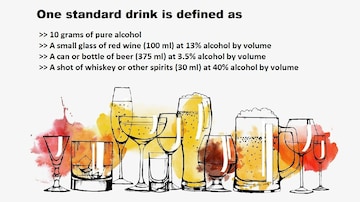
Drinking is injurious to health, but a recent study funded by The Bill and Melinda Gates Foundation has given some wiggle room to tipplers, recommending an average daily intake of alcohol that minimises health risks. Currently, standard drinks are different for men and women worldwide. But this study, published in The Lancet, says the global alcohol consumption recommendations should be based on age and location. It adds that the strictest guidelines should be set for men between the ages 15-39, who are at the greatest risk of harmful alcohol consumption worldwide.
"...we recommend a modification of existing policy guidelines to focus on emphasising differential optimal consumption levels by age, rather than the current practice of recommending different consumption levels by sex," revealed researchers who analysed the 2020 Global Burden of Disease data for men and women — aged 15-95 years and older, between 1990 and 2020, in 204 countries and territories.
Key findings:
>> 1.34 billion people consumed harmful amounts of alcohol in 2020.
>> Young people face higher health risks from alcohol consumption than those older. "Harmful consumption was predominantly concentrated among individuals aged 15–39 years."
>> About 60 percent of alcohol-related incidents occur among people in 15–39 age group, including motor vehicle accidents, suicides, and homicides
>> Young people should not drink, but older people may benefit from drinking small amounts, study author Emmanuela Gakidou was quoted by PTI as saying.
>> The results suggest that guidelines should not incorporate sex-specific recommendations, given the absence of variation in TMREL and NDE by sex across geographies. In simple terms, TMREL is theoretical minimum risk exposure level. It refers to the lowest level of the risk factor plausible in a population. NDE is an abbreviation for non-drinker equivalence. The study suggested: "The TMREL and NDE did not vary significantly by sex or year...there was significant variation in the TMREL and the NDE across ages".
What is a standard drink?

As per the researchers, the recommended amount of alcohol for people aged 15-39 before risking health loss was 0.136 standard drinks per day — a little more than one-tenth of a standard drink. That amount was slightly higher for women aged 15-39 years at 0.273 drinks — about a quarter of a standard drink per day.
In 2020, for individuals aged 40-64 years in 2020, safe alcohol consumption levels ranged from about half a standard drink per day (0.527 drinks for men and 0.562 standard drinks per day for women) to almost two standard drinks (1.69 standard drinks per day for men and 1.82 for women), researchers said.
For individuals over 65 years in 2020, the risks of health loss from alcohol consumption were reached after consuming a little more than three standard drinks per day (3.19 drinks for men and 3.51 for women).
Are there any recommendations on standard drinks in India?
No. There aren't any such guidelines in India as of now. But Dr Atul Ambekar, MD Professor at National Drug Dependence Treatment Centre and Department of Psychiatry at AIIMS Delhi, suggests: "If one has to consume, follow the international guidelines (not more than 2 drinks on any occasion)".
In the absence of any guidelines in India, Dr Ambekar said, "In my opinion, we should conduct research in India and develop India-specific recommendations about the same (looking at the local evidence and the contexts). This is not going to be an easy task considering the significant diversity and heterogeneity within the country."
However, cautioning against consumption of any amount of alcohol, the doctor said, "There is no reason for which alcohol can be recommended in any amount as ‘good for health’"
Why are there different guidelines for men and women?
The health risks of alcohol consumption are different for men and women. Reason for this are "various biological factors", said Dr Ambekar. "...owing to various biological factors women tend to experience adverse effects of drinking at much lower amounts as compared to men. This is a purely biological phenomena and there is no value judgement involved here."
"But, we know that whether we regard it as fair or unfair — society tends to look at alcohol consumption by men and women differently. In fact, the bar is set differently for what is ‘acceptable’ for most of the behaviours for both the sexes," he said.
In contradiction, the Lancet study suggested that the recommendations should be made while keeping in view age and location, rather than sex.
(With inputs from PTI)
First Published: Jul 15, 2022 3:27 PM IST
Check out our in-depth Market Coverage, Business News & get real-time Stock Market Updates on CNBC-TV18. Also, Watch our channels CNBC-TV18, CNBC Awaaz and CNBC Bajar Live on-the-go!


Andhra Pradesh Lok Sabha elections: A look at YSRCP candidates
Apr 25, 2024 6:54 PM
Lok Sabha elections 2024: Banks and schools to remain closed in these cities for phase 2 voting
Apr 25, 2024 5:33 PM
Andhra Pradesh Lok Sabha elections: Seats, schedule, NDA candidates and more
Apr 25, 2024 5:16 PM

